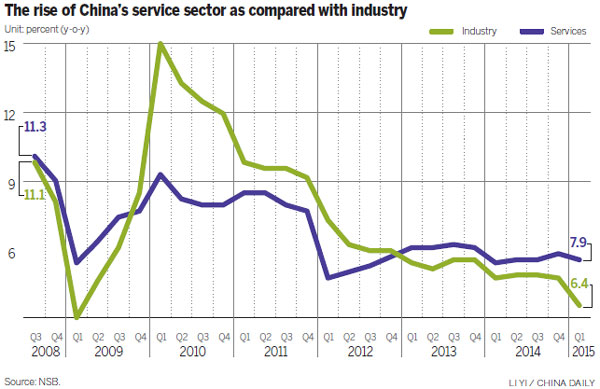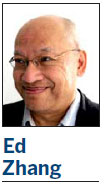Truths rooted in a colorful turn of phrase
Updated: 2015-04-17 07:01
By Ed Zhang(China Daily Europe)
|
|||||||||||
Services are the key to tiding over the economy during a period of transition
The official Xinhua News Agency did not use the term. But people who attended a symposium on the "economic situation" told Chinese business media about one important phrase Premier Li Keqiang used. He said the state of the Chinese economy was "between green and yellow", meaning between crop harvests.
Well, the phrase is important to me. And I believe Li and I are like-minded on this issue, otherwise he would not have used the phrase. It is one he and I and many of our age learned from working with farmers during the Mao era. I was on a large state-owned plantation in Xinjiang autonomous region, and he was on a People's Commune in Anhui province.

In those days life for a farmer's household could be very tough between harvests, as it always had been in such an agrarian society. You ran out of stock from the last harvest (yellow) even though the crop from the next harvest was still not ripe (green).
Despite the phrase's agricultural roots, it is perfectly apposite for China's economy today. The glories that it achieved in the 1980s, 1990s, 2000s, and even the few years immediately after the 2008 global financial crisis, are all past - not just the dazzling numbers of China's high-growth GDP but also the way they were achieved.
A number of industries have been overbuilt and will not generate healthy returns for their owners the way they operate. Industrial growth was only 6.4 percent year-on-year in the first quarter of the year, a drop of almost a percentage point from three months ago, the fourth quarter of 2014.
In fact, industrial growth has never been so weak since the first quarter of 2009. The setback in 2009 was because of the drastic cancellation of orders from potential importers of Chinese products. And a lack of demand can also explain the sluggish growth now. It is, of course, the demand for the same goods that Chinese factories can turn out en masse.

A reading of China's growth pattern over the years easily reveals where new, unmet demand may be. That is the demand from its 1.4 billion people, especially its growing number of urban, middle-class consumers, for better services.
Services have never been given as much political emphasis and financial incentives as other industries. In fact services have performed quite well since 2008 - despite the severe measures that the government has taken to cool down the housing market.
And just think of the services a regular consumer can expect in a regular Chinese city other than its downtown area. From small eateries to hostelries, most of them would be from the various small, hardly standardized mum-and-dad type providers.
In no place other than McDonalds or KFC can middle-school students find a place to hang out together and do some after-school reading. In no teahouse, and in a country of such a rich tea tradition, can young professionals find a decent place to relax other than Starbucks and similar cafes.
In the areas of the greatest thirst for decent services, such as health and medicine and education, state bureaucracies remain in control of most resources and can fine everyone else into bankruptcy.
In bygone days one of the things farming households would do between harvests was to trade a few things, including their skills, at the village fair for some extra cash in order to buy a few things to tide them over. Service, as simple as it may be, is always part of the standard solution to such transitional difficulties.
The same may be true of China today. The economy's transitional stage will be less bumpy if more service areas are liberalized.
The author is editor-at-large of China Daily. Contact the writer at edzhang@chinadaily.com.cn
(China Daily European Weekly 04/17/2015 page13)
Today's Top News
AIIB to operate in 'transparent way'
PLA to buy advanced missiles from Russia
EU accuses Google of hurting consumers, competitors
Q1 economic data: what the economists say
Holocaust memories to live on
Problem-plagued Milan Expo battles a long list of headaches
Foreign ministers call for end to fighting in east Ukraine
Spotlight set to shine on royal sibling
Hot Topics
Lunar probe , China growth forecasts, Emission rules get tougher, China seen through 'colored lens', International board,
Editor's Picks

|

|

|

|

|

|






